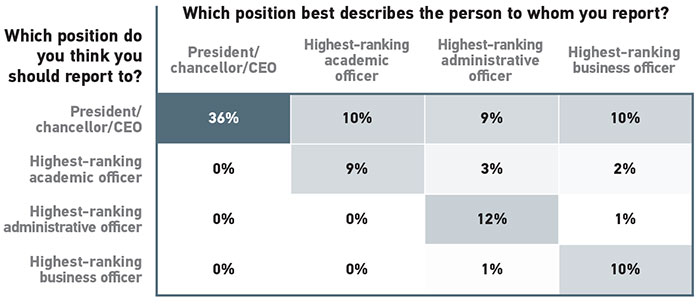Reporting Lines: Actual and Desired
Despite the generally standardized role of the CIO in higher education, the reporting lines associated with the position vary considerably. We asked CIOs to tell us which position best describes the person to whom they report, and we received at least one response to each of the 10 options offered. The overwhelming majority (87%) of respondents told us that they report to one of the top four positions at their respective institutions. A plurality (29%) of CIOs said that they report directly to the president, chancellor, or CEO of their institution. Another quarter (23%) report to the highest-ranking administrative officer (the administrative vice president/vice chancellor or the executive vice president). One-fifth (19%) report to the highest-ranking business officer (the vice president or vice chancellor, the business office, or chief financial officer), and 16% report to the highest-ranking academic officer (the provost, academic vice president or vice chancellor, or dean).1 The reporting lines of the remaining 13% of CIOs include second-level academic or administrative officers, joint reporting lines to combinations of the highest-ranking officers, or some other position.
These findings become even more interesting when we ask CIOs to whom they think they should report. One of the best predictors of whom CIOs believe they should report to is the person to whom they currently report (figure 2). All of the CIOs who currently report to the president, chancellor, or CEO told us that their reporting line is just as it should be. But approximately half of CIOs who reported to one of the other highest-ranking officer positions told us that they think they should be reporting to the president, chancellor, or CEO.

To understand why CIOs tend to think they should report directly to the president, chancellor, or CEO, we provided respondents an opportunity to tell us in their own words. An analysis of those qualitative data reveals a largely consonant but wide-ranging set of reasons. One of the more practical sets of responses had to do with pragmatic aspects of the organizational chart. As one respondent put it, a "C-suite position should not report to a C-suite position." Another pointed out that a "cabinet-level decision-maker should report to the cabinet chair." These organizational concerns dovetailed with another set of concerns about maintaining organizational independence and institutional neutrality. Specifically, several CIOs told us that reporting to the CFO or provost could introduce bias in favor of one or the other when "the provost is as much our customer as the CFO is." The conflicts of interest that emerge for an IT organization whose mission is to serve the entire institution but is governed by a more narrowly focused arm of the institution were cited by several as a reason for their preference that the CIO report to the president, chancellor, or CEO.
Another key justification for a presidential reporting line is the increasingly strategic importance of the role of IT for higher education, a principle articulated forcefully by the Association of Governing Boards (AGB) of Universities and Colleges in a recent report.2 In this report, the AGB Board of Directors take the position that "successful innovation demands the governing board's attention to the strategic role of technology." The AGB report maintains that since technology is foundational to practically every innovative strategy, boards need to ensure that technologists are involved in all stages of strategic projects. It concludes that the best way for presidents to guarantee the strategic prioritization of technology is to make sure the CIO is "at the table when key decisions are made at the cabinet level."3
The strategic importance of IT for the institutional mission is not lost on current CIOs. Often alluding to the digital transformation that higher education is experiencing, several CIOs expressed a desire to report to the president/chancellor/CEO precisely because of the role technology plays in campus innovation. One respondent made this point explicitly: "IT is pervasive in an institution, and being at the strategic decision table is vitally important to using technology effectively, setting IT priorities, and influencing decisions." This sentiment was also woven throughout many of the comments citing the responsibility of IT to support "all areas of the university" since "technology affects the entire campus community" and "creates value for the campus community."
A CIO who reports directly to the president, chancellor, or CEO is also in an authoritative position to communicate the strategic importance of technology initiatives to the administration, campus stakeholders, and end users. As one CIO told us, "The culture is such that reporting to the president is critical to my ability to execute, which is built in part on being seen as a cabinet member with the authority that role implies on my campus." Another respondent hammered this point home: "The impact of technology services on all campus activities is enormous, and as the representative of that division I am uniquely qualified to provide the president with insight on various issues."
Clearly, not every institution is organized in a manner that can accommodate a direct reporting line of the CIO to the president, chancellor, or CEO. However, those institutions that do not have this reporting line in place but have the organizational capacity to bring IT into the purview of the executive office should consider the potential benefits of doing so.
Notes
-
These numbers are roughly similar to the actual reporting lines EDUCAUSE has documented in the 2018 Core Data Service (CDS) survey in which 34% of CIOs report to the president or the chancellor, 23% report to the highest-ranking administrative officer, 19% report to the highest-ranking business officer, and 17% report to the highest-ranking academic officer.
↩︎ -
AGB Board of Directors, AGB Board of Directors' Statement on Innovation in Higher Education (Washington, D.C.: Association of Governing Boards of Universities and Colleges, November 7, 2017).
↩︎ -
Ibid., 14.
↩︎